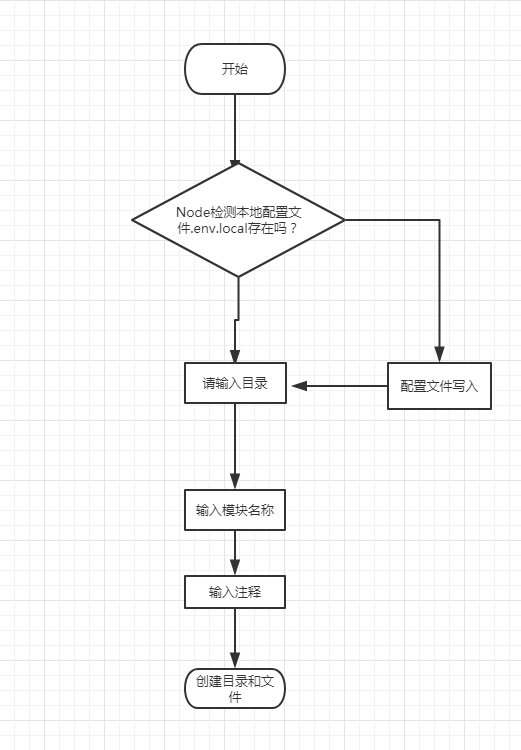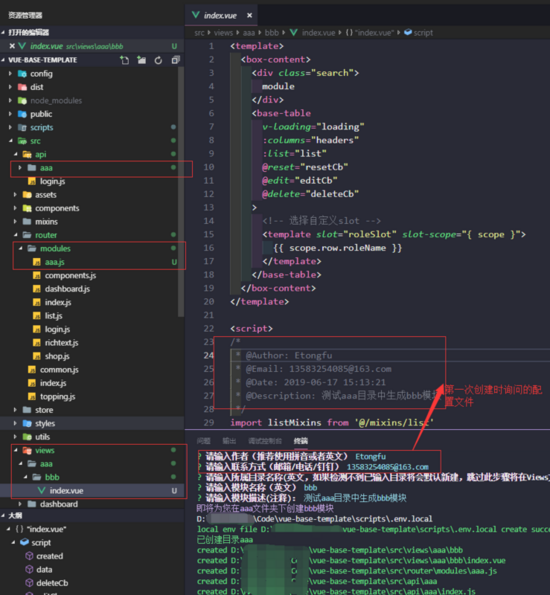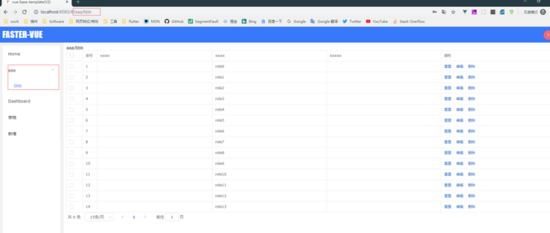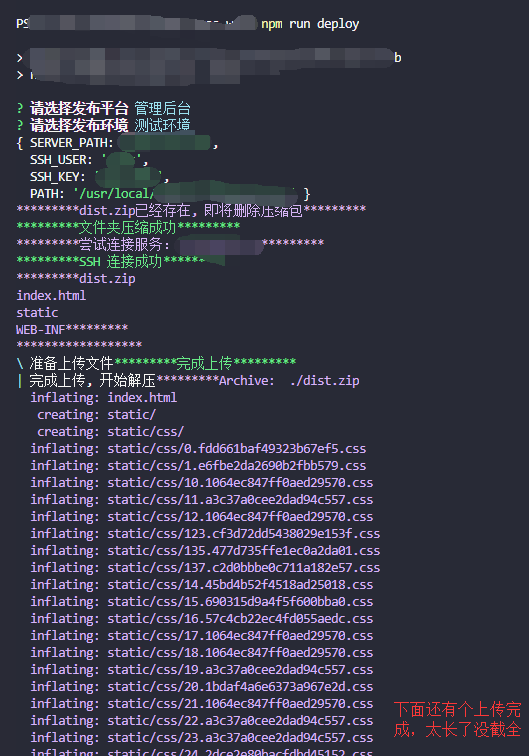近些年来借着 NodeJS 的春风,前端经历了一波大洗牌式得的发展。使得前端开发在效率,质量上有了质的飞跃。可以说 NodeJS 已经是前端不可欠缺的技能了。但是是事实上大部分的前端对于本地安装的 NodeJS 的使用可能仅限于 node -v 和 npm 了:joy:。其实 NodeJS 作为真正意义上的服务端语言,在我们开发的时候可以运用 NodeJS 强大的模块和众多的 npm 包来为我们自己服务。
注意:这篇文章基本上不会去将一些非常基础的东西,希望大家自备 ES6+ 语法, NodeJS 基础, 简单的 Linux 操作等知识。还有这篇文章侧重点不会放在技术的实现细节,主要是提供一些思路和方向。更加深层次的使用,还是要各位朋友自己去挖掘。而且这篇文章会有点长:ticket:
这个部分我之前在 加快Vue项目的开发速度 中提到过,不过那个版本写的比较简单(糙),而且基本全都都是通过 Node 写的。说白了就是用 NodeJS 去代替我们生成需要复制粘贴的代码。
在大型的项目中,尤其是中后台项目在开发一个新的业务模块的时候可能离不开大量的复制粘贴,像中后台项目中可能很多模块都是标准的 CURD 模块,包括了 列表,新增,详情,编辑 这些页面。那么这就意味着有大量的重复代码存在,每次复制粘贴完之后还有修修改改删删等一大堆麻烦事儿,最重要的是复制粘贴很容易忘记哪一部分就忘记改了,导致项目做的很糙而且也会浪费不少时间。那我们的需求就是把人工复制粘贴的那部分交给 Node 去做,力求 时间和质量 得到双重的保障。
之前在 Vue 项目中写过这个模块,那接下来的 demo 我们以一个 Vue 项目来做示例, 项目地址 。
文件结构划分:视图文件,路由文件, Controler 文件该怎么放一定要划分清楚。这个就像是地基,可以根据自己项目的业务去划分,我们的项目目录是下面这样划分
vue-base-template │ config // webpack配置config/q其他一些config文件 │ scripts // 帮助脚本文件 ===> 这里存放我们的项目脚本文件 │ │ template // 模块文件 │ │ build-module.js // build构建脚本 │ │ └───src // 业务逻辑代码 │ │ api // http api 层 │ └── router // 路由文件 │ │ │ modules // 业务路由文件夹 ==> 业务模块路由生成地址 │ │ │ module.js // 制定模块 │ │ store // vuex │ └── views // 视图文件 │ │ │ directory // 抽象模块目录 │ │ │ │ module // 具体模块文件夹 │ │ │ │ │ index.vue // 视图文件 │ │ global.js // 全局模块处理 │ │ main.js // 入口文件
业务模块我基本上是通过 抽象模块+具体模块 的方式去划分:
这个划分方式很灵活,主要是根据自己的需求来。
.vue 这种文件 技术准备:
理论上来讲我们需要用到以下一些 npm 模块, 起码要知道这个都是干什么的
dotenv : 配置文件管理 inquirer : 命令行交互 chalk : 美化命令行输出 创建流程
流程很简单我画的也不好,凑合看吧。抽空我会重新画的:joy:

自从有了这个想法之后, 这个脚本到现在已经是我第三遍撸了。从第一次的单一简单,到现在的功能完善。我最大的感触就是这个东西开发起来好像没有什么尽头,每一次都能找到不一样的需求点,每次都能找到可以优化的部分。针对自己的项目,脚本可以很简单也可以很复杂。很魔性, 对我来说肯定还有第四次第五次的重构。
为了后期的维护,我把所有的脚本相关 NodeJS 代码放到了根目录下的 scripts 文件夹中
scripts // 帮助脚本文件 ===> 这里存放我们的项目脚本文件 └───template // template管理文件夹 │ │ index.js // 模块文件处理中心 │ │ api.template.js // api模块文件 │ │ route.template.js // route模块文件 │ │ template.vue // view模块文件 │ build-module.js // 创建脚本入口文件 │ │ | .env.local // 本地配置文件 │ │ │ util.js // 工具文件
下面我们一个部分一个部分的来讲这些文件的作用(大量代码预警)
build-module.js : 入口文件, 与使用者进行交互的脚本。 通过问答的方式得到我们需要的三个核心变量 目录(抽象模块), 模块(具体模块), 注释 。如果是第一次执行这个脚本, 那么还会有配置相关的问题, 第一次设置完之后接下来的使用将不会再询问,若想修改可自己修改 .env.local 文件。这里我不详细描述了, 大部分解释都写在注释里面了。 第一部分 配置文件已经输入项处理部分
const inquirer = require('inquirer')
const path = require('path')
const { Log, FileUtil, LOCAL , ROOTPATH} = require('./util')
const { buildVueFile, buildRouteFile, buildApiFile, RouteHelper } = require('./template')
const EventEmitter = require('events');
// file options
const questiOns= [
{
type: 'input',
name: 'folder',
message: "请输入所属目录名称(英文,如果检测不到已输入目录将会默认新建,跳过此步骤将在Views文件夹下创建新模块):"
},
{
type: 'input',
name: 'module',
message: "请输入模块名称(英文)",
// 格式验证
validate: str => ( str !== '' && /^[A-Za-z0-9_-]+$/.test(str))
},
{
type: 'input',
name: 'comment',
message: "请输入模块描述(注释):"
},
]
// local configs
const cOnfigQuestion= [
{
type: 'input',
name: 'AUTHOR',
message: "请输入作者(推荐使用拼音或者英文)",
// 格式验证
validate: str => ( str !== '' && /^[\u4E00-\u9FA5A-Za-z]+$/.test(str)),
when: () => !Boolean(process.env.AUTHOR)
},
{
type: 'input',
name: 'Email',
message: "请输入联系方式(邮箱/电话/钉钉)"
}
]
// Add config questions if local condfig does not exit
if (!LOCAL.hasEnvFile()) {
questions.unshift(...configQuestion)
}
// 获取已经完成的答案
inquirer.prompt(questions).then(answers => {
// 1: 日志打印
Log.logger(answers.folder == '' ? '即将为您' : `即将为您在${answers.folder}文件夹下` + `创建${answers.module}模块`)
// 2: 配置文件的相关设置
if (!LOCAL.hasEnvFile()) {
LOCAL.buildEnvFile({
AUTHOR: answers.AUTHOR,
Email: answers.Email
})
}
// 3: 进入文件和目录创建流程
const {
folder, // 目录
module, // 模块
comment // 注释
} = answers
buildDirAndFiles(folder, module, comment)
})
// 事件处理中心
class RouteEmitter extends EventEmitter {}
// 注册事件处理中心
const routeEmitter = new RouteEmitter()
routeEmitter.on('success', value => {
// 创建成功后正确退出程序
if (value) {
process.exit(0)
}
})
第二部分 实际操作部分
// module-method map
// create module methods
const generates = new Map([
// views部分
// 2019年6月12日17:39:29 完成
['view', (folder, module, isNewDir , comment) => {
// 目录和文件的生成路径
const folderPath = path.join(ROOTPATH.viewsPath,folder,module)
const vuePath = path.join(folderPath, '/index.vue')
// vue文件生成
FileUtil.createDirAndFile(vuePath, buildVueFile(module, comment), folderPath)
}],
// router is not need new folder
['router', (folder, module, isNewDir, comment) => {
/**
* @des 路由文件和其他的文件生成都不一样, 如果是新的目录那么生成新的文件。
* 但是如果module所在的folder 已经存在了那么就对路由文件进行注入。
* @reason 因为我们当前项目的目录分层结构是按照大模块来划分, 即src下一个文件夹对应一个router/modules中的一个文件夹
* 这样做使得我们的目录结构和模块划分都更加的清晰。
*/
if (isNewDir) {
// 如果folder不存在 那么直接使用module命名 folder不存在的情况是直接在src根目录下创建模块
const routerPath = path.join(ROOTPATH.routerPath, `/${folder || module}.js`)
FileUtil.createDirAndFile(routerPath, buildRouteFile(folder, module, comment))
} else {
// 新建路由helper 进行路由注入
const route = new RouteHelper(folder, module, routeEmitter)
route.injectRoute()
}
}],
['api', (folder, module, isNewDir, comment) => {
// inner module will not add new folder
// 如果当前的模块已经存在的话那么就在当前模块的文件夹下生成对应的模块js
const targetFile = isNewDir ? `/index.js` : `/${module}.js`
// 存在上级目录就使用上级目录 不存在上级目录的话就是使用当前模块的名称进行创建
const filePath = path.join(ROOTPATH.apiPath, folder || module)
const apiPath = path.join(filePath, targetFile)
FileUtil.createDirAndFile(apiPath, buildApiFile(comment), filePath)
}]
])
/**
* 通过我们询问的答案来创建文件/文件夹
* @param {*} folder 目录名称
* @param {*} module 模块名称
* @param {*} comment 注释
*/
function buildDirAndFiles (folder, module, comment) {
let _tempFloder = folder || module // 临时文件夹 如果当前的文件是
let isNewDir
// 如果没有这个目录那么就新建这个目录
if (!FileUtil.isPathInDir(_tempFloder, ROOTPATH.viewsPath)) {
rootDirPath = path.join(ROOTPATH.viewsPath, _tempFloder)
// create dir for path
FileUtil.createDir(rootDirPath)
Log.success(`已创建${folder ? '目录' : "模块"}${_tempFloder}`)
isNewDir = true
} else {
isNewDir = false
}
// 循环操作进行
let _arrays = [...generates]
_arrays.forEach((el, i) => {
if (i <_arrays.length) {
el[1](folder, module, isNewDir, comment)
} else {
Log.success("模块创建成功!")
process.exit(1)
}
})
}
注: 这里我用了一个 generates 这个 Map 去管理了所有的操作,因为上一个版本是这么写我懒得换了,你也可以用一个二维数组或者是对象去管理, 也省的写条件选择了。
template : 管理着生成文件使用的模板文件( vue文件,路由文件, api文件 ),我们只看其中的 route.template.js ,其他的部分可以参考项目 /*
* @Author: _author_
* @Email: _email_
* @Date: _date_
* @Description: _comment_
*/
export default [
{
path: "/_mainPath",
component: () => import("@/views/frame/Frame"),
redirect: "/_filePath",
name: "_mainPath",
icon: "",
noDropdown: false,
children: [
{
path: "/_filePath",
component: () => import("@/views/_filePath/index"),
name: "_module",
meta: {
keepAlive: false
}
}
]
}
]
在 template 中最重要的要属 index.js 了, 这个文件主要是包含了 模板文件的读取和重新生成出我们需要的模板字符串, 以及生成我们需要的特定路由代码 。 template/index.js ,文件模板的生成主要是通过读取各个模板文件并转化成字符串,并把的 指定的字符串用我们期望的变量去替换 , 然后返回新的字符串给生成文件使用。
const fs = require('fs')
const path = require('path')
const os = require('os')
const readline = require('readline')
const {Log, DateUtil, StringUtil , LOCAL, ROOTPATH} = require('../util')
/**
* 替换作者/时间/日期等等通用注释
* @param {*string} content 内容
* @param {*string} comment 注释
* @todo 这个方法还有很大的优化空间
*/
const _replaceCommOnContent= (content, comment) => {
if (cOntent=== '') return ''
// 注释对应列表 comments = [ [文件中埋下的锚点, 将替换锚点的目标值] ]
const comments = [
['_author_', LOCAL.config.AUTHOR],
['_email_', LOCAL.config.Email],
['_comment_', comment],
['_date_', DateUtil.getCurrentDate()]
]
comments.forEach(item => {
cOntent= content.replace(item[0], item[1])
})
return content
}
/**
* 生成Vue template文件
* @param {*} moduleName 模块名称
* @returns {*string}
*/
module.exports.buildVueFile = (moduleName, comment) => {
const VueTemplate = fs.readFileSync(path.resolve(__dirname, './template.vue'))
const builtTemplate = StringUtil.replaceAll(VueTemplate.toString(), "_module_", moduleName)
return _replaceCommonContent(builtTemplate, comment)
}
/**
* @author: etongfu
* @description: 生成路由文件
* @param {string} folder 文件夹名称
* @param {string} moduleName 模块名称
* @returns {*string}
*/
module.exports.buildRouteFile = (folder,moduleName, comment) => {
const RouteTemplate = fs.readFileSync(path.resolve(__dirname, './route.template.js')).toString()
// 因为路由比较特殊。路由模块需要指定的路径。所以在这里重新生成路由文件所需要的参数。
const _mainPath = folder || moduleName
const _filePath = folder == '' ? `${moduleName}` : `${folder}/${moduleName}`
// 进行替换
let builtTemplate = StringUtil.replaceAll(RouteTemplate, "_mainPath", _mainPath) // 替换模块主名称
builtTemplate = StringUtil.replaceAll(builtTemplate, "_filePath", _filePath) // 替换具体路由路由名称
builtTemplate = StringUtil.replaceAll(builtTemplate, "_module", moduleName) // 替换模块中的name
return _replaceCommonContent(builtTemplate, comment)
}
/**
* @author: etongfu
* @description: 生成API文件
* @param {string} comment 注释
* @returns: {*}
*/
module.exports.buildApiFile = comment => {
const ApiTemplate = fs.readFileSync(path.resolve(__dirname, './api.template.js')).toString()
return _replaceCommonContent(ApiTemplate, comment)
}
在这个文件夹中,需要额外注意的是 RouteHelper 这个 class ,这个是对已存在的路由文件进行新模块的路由注入操作,主要通过了 stream(流) , readline(逐行读取) 来实现的。
接下来是干货部分 ==> 首先通过参数找到我们的目标路由文件,然后通过 generateRouter() 来拼接生成我们需要注入的路由。通过 injectRoute 方法开始注入路由,在 injectRoute 中我们首先来生成一个名字为 _root 临时路径的文件并根据这个路径创建一个 writeStream , 然后根据旧的路由文件地址 root 创建一个 readStream 并通过 readline 读写接口去读取原来的路由文件,用一个数组收集旧的路由每一行的数据。读取完毕之后开始遍历 temp 这个数组并找到第一个 children 然后把 generateRouter() 方法返回的数组插入到这个位置。最后使用拼接完成的 temp 遍历逐行写入 writeStream 中。最后把原来的 root 文件删除,把 _root 重命名为 root 。一个路由注入的流程就完了。大体的流程就是这样, 关于代码细节不懂得朋友们可以私信我:grin:。
/**
* @author: etongfu
* @description: 路由注入器
* @param {string} dirName
* @param {string} moduleName
* @param {event} event
* @returns: {*}
*/
module.exports.RouteHelper = class {
constructor (dirName, moduleName, event) {
// the dir path for router file
this.dirName = dirName
// the path for router file
this.moduleName = moduleName
// 事件中心
this.event = event
// route absolute path
this.modulePath = path.join(ROOTPATH.routerPath, `${dirName}.js`)
}
/**
* Generate a router for module
* The vue file path is @/name/name/index
* The default full url is http:xxxxx/name/name
* @param {*} routeName url default is router name
* @param {*string} filePath vue file path default is ${this.dirName}/${this.moduleName}/index
* @returns {*Array} A string array for write line
*/
generateRouter (routeName = this.moduleName, filePath = `${this.dirName}/${this.moduleName}/index`) {
let temp = [
` // @Author: ${LOCAL.config.AUTHOR}`,
` // @Date: ${DateUtil.getCurrentDate()}`,
` {`,
` path: "/${this.dirName}/${routeName}",`,
` component: () => import("@/views/${filePath}"),`,
` name: "${routeName}"`,
` },`
]
return temp
}
/**
* add router to file
*/
injectRoute () {
try {
const root = this.modulePath
const _root = path.join(ROOTPATH.routerPath, `_${this.dirName}.js`)
// temp file content
let temp = []
// file read or write
let readStream = fs.createReadStream(root)
// temp file
let writeStream = fs.createWriteStream(_root)
let readInterface = readline.createInterface(
{
input: readStream
// output: writeStream
}
)
// collect old data in file
readInterface.on('line', (line) => {
temp.push(line)
})
// After read file and we begin write new router to this file
readInterface.on('close', async () => {
let _index
temp.forEach((line, index) => {
if (line.indexOf('children') !== -1) {
_index = index + 1
}
})
temp = temp.slice(0, _index).concat(this.generateRouter(), temp.slice(_index))
// write file
temp.forEach((el, index) => {
writeStream.write(el + os.EOL)
})
writeStream.end('\n')
// 流文件读写完毕
writeStream.on('finish', () => {
fs.unlinkSync(root)
fs.renameSync(_root, root)
Log.success(`路由/${this.dirName}/${this.moduleName}注入成功`)
//emit 成功事件
this.event.emit('success', true)
})
})
} catch (error) {
Log.error('路由注入失败')
Log.error(error)
}
}
}
关于路由注入这一块我自己这么设计其实并不是很满意,有更好的方法还请大佬告知一下。
.env.local : 配置文件, 这个是第一次使用脚本的时候生成的。没啥特别的,就是记录本地配置项。 AUTHOR = etongfu Email = 13583254085@163.com
util.js : 各种 工具 方法,包含了 date, file, fs, string, Log, ROOTPATH 等等工具方法, 篇幅有限我就贴出来部分代码, 大家可以在项目中查看全部代码 const chalk = require('chalk')
const path = require('path')
const dotenv = require('dotenv')
const fs = require('fs')
// 本地配置相关
module.exports.LOCAL = class {
/**
* env path
*/
static get envPath () {
return path.resolve(__dirname, './.env.local')
}
/**
* 配置文件
*/
static get config () {
// ENV 文件查找优先查找./env.local
const ENV = fs.readFileSync(path.resolve(__dirname, './.env.local')) || fs.readFileSync(path.resolve(__dirname, '../.env.development.local'))
// 转为config
const envCOnfig= dotenv.parse(ENV)
return envConfig
}
/**
* 创建.env配置文件文件
* @param {*} config
* @description 创建的env文件会保存在scripts文件夹中
*/
static buildEnvFile (cOnfig= {AUTHOR: ''}) {
if (!fs.existsSync(this.envPath)) {
// create a open file
fs.openSync(this.envPath, 'w')
}
let cOntent= ''
// 判断配置文件是否合法
if (Object.keys(config).length > 0) {
// 拼接内容
for (const key in config) {
let temp = `${key} = ${config[key]}\n`
content += temp
}
}
// write content to file
fs.writeFileSync(this.envPath, content, 'utf8')
Log.success(`local env file ${this.envPath} create success`)
}
/**
* 检测env.loacl文件是否存在
*/
static hasEnvFile () {
return fs.existsSync(path.resolve(__dirname, './.env.local')) || fs.existsSync(path.resolve(__dirname, '../.env.development.local'))
}
}
// 日志帮助文件
class Log {
// TODO
}
module.exports.Log = Log
// 字符串Util
module.exports.StringUtil = class {
// TODO
}
// 文件操作Util
module.exports.FileUtil = class {
// TODO
/**
* If module is Empty then create dir and file
* @param {*} filePath .vue/.js 文件路径
* @param {*} content 内容
* @param {*} dirPath 文件夹目录
*/
static createDirAndFile (filePath, content, dirPath = '') {
try {
// create dic if file not exit
if (dirPath !== '' && ! fs.existsSync(dirPath)) {
// mkdir new dolder
fs.mkdirSync(dirPath)
Log.success(`created ${dirPath}`)
}
if (!fs.existsSync(filePath)) {
// create a open file
fs.openSync(filePath, 'w')
Log.success(`created ${filePath}`)
}
// write content to file
fs.writeFileSync(filePath, content, 'utf8')
} catch (error) {
Log.error(error)
}
}
}
// 日期操作Util
module.exports.DateUtil = class {
// TODO
}
在 Util 文件中需要注意的部分可能是 .env 文件的生成和读取这一部分和 FileUtil 中 createDirAndFile , 这个是我们用来生成文件夹和文件的方法,全部使用 node 文件系统完成。熟悉了 API 之后不会有难度。
Util 文件中有一个 ROOTPATH 要注意一下指的是我们的 路由,views, api的根目录配置 , 这个配置的话我建议不要写死, 因为如果你的项目有多入口或者是子项目,这些可能都会变。你也可以选择其他的方式进行配置。
// root path
const reslove = (file = '.') => path.resolve(__dirname, '../src', file)
const ROOTPATH = Object.freeze({
srcPath: reslove(),
routerPath: reslove('router/modules'),
apiPath: reslove('api'),
viewsPath: reslove('views')
})
module.exports.ROOTPATH = ROOTPATH
这样的话我们就能愉快的通过命令行快速的创建模块了, 效果如下

运行

虽然这些事儿复制粘贴也能完成,但是通过机器完成可靠度和可信度都会提升不少。 我们的前端团队目前已经全面使用脚本来创建新模块,并且脚本在不断升级中。亲测在一个大项目中这样一个脚本为团队节约的时间是非常可观的 , 建议大家有时间也可以写一写这种脚本为团队或者自己节约下宝贵的时间:grin:
在开发过程中,有很多工作都是机械且无趣的。不拿这些东西开刀简直对不起他们
注: 如果团队部署了 CI/CD ,这个部分可以直接忽略。
经过我的观察,很多前端 程序员 并不懂 Linux 操作, 有的时候发布测试还需要去找同事帮忙,如果另一个同事 Linux 功底也不是很好的话,那就可能浪费两个人的很大一块儿时间。今天通过写一个脚本让我们的所有同事都能独立的发布测试。这个文件同样放在项目的 scripts 文件夹下
Web 服务器, 不会的话可以看我之前的一篇文章 服务器发布Vue项目指南 需要的技术,都是工具类的包 没什么难度
inquirer : 命令行交互 chalk : 美化命令行输出 ora : 命令行 loading shelljs : 执行 shell 命令 node-ssh : node SSH node-ssh : node SSH zip-local : zip 压缩 因为是发布到不同的服务器, 因为 development/stage/production 应该都是不同的服务器,所以我们需要一个配置文件来管理服务器。
deploy.config.js
module.exports = Object.freeze({
// development
development: {
SERVER_PATH: "xxx.xxx.xxx.xx", // ssh地址
SSH_USER: "root", // ssh 用户名
SSH_KEY: "xxx", // ssh 密码 / private key文件地址
PATH: '/usr/local' // 操作开始文件夹 可以直接指向配置好的地址
},
// stage
stage: {
SERVER_PATH: "",
SSH_USER: "",
SSH_KEY: "",
PATH: ''
},
// production
production: {
SERVER_PATH: "",
SSH_USER: "",
SSH_KEY: "",
PATH: ''
}
})
配置文件配置好了下面开始写脚本, 我们先确定下来流程
inquirer 问问题,这是个示例代码, 问题就比较简单了, 在真正使用中包括了 发布平台 等等不同的发布目标。 dist 文件,通过 zip-local 去操作。很简单 node-ssh 连接上服务器 SSH 的 putFile 方法开始把本地文件上传到服务器。 unzip 命令。 8: 发布完成:balloon:
下面是干货代码
第一部分 实际操作部分, 链接 SSH , 压缩文件等等
const fs = require('fs')
const path = require('path')
const ora = require('ora')
const zipper = require('zip-local')
const shell = require('shelljs')
const chalk = require('chalk')
const COnFIG= require('../config/release.confg')
let config
const inquirer = require('inquirer')
const node_ssh = require('node-ssh')
let SSH = new node_ssh()
// loggs
const errorLog = error => console.log(chalk.red(`*********${error}*********`))
const defaultLog = log => console.log(chalk.blue(`*********${log}*********`))
const successLog = log => console.log(chalk.green(`*********${log}*********`))
// 文件夹位置
const distDir = path.resolve(__dirname, '../dist')
const distZipPath = path.resolve(__dirname, '../dist.zip')
// ********* TODO 打包代码 暂时不用 需要和打包接通之后进行测试 *********
const compileDist = async () => {
// 进入本地文件夹
shell.cd(path.resolve(__dirname, '../'))
shell.exec(`npm run build`)
successLog('编译完成')
}
// ********* 压缩dist 文件夹 *********
const zipDist = async () => {
try {
if(fs.existsSync(distZipPath)) {
defaultLog('dist.zip已经存在, 即将删除压缩包')
fs.unlinkSync(distZipPath)
} else {
defaultLog('即将开始压缩zip文件')
}
await zipper.sync.zip(distDir).compress().save(distZipPath);
successLog('文件夹压缩成功')
} catch (error) {
errorLog(error)
errorLog('压缩dist文件夹失败')
}
}
// ********* 连接ssh *********
const cOnnectSSh= async () =>{
defaultLog(`尝试连接服务: ${config.SERVER_PATH}`)
let spinner = ora('正在连接')
spinner.start()
try {
await SSH.connect({
host: config.SERVER_PATH,
username: config.SSH_USER,
password: config.SSH_KEY
})
spinner.stop()
successLog('SSH 连接成功')
} catch (error) {
errorLog(err)
errorLog('SSH 连接失败');
}
}
// ********* 执行清空线上文件夹指令 *********
const runCommOnd= async (commond) => {
const result = await SSH.exec(commond,[], {cwd: config.PATH})
defaultLog(result)
}
const commOnds= [`ls`, `rm -rf *`]
// ********* 执行清空线上文件夹指令 *********
const runBeforeCommand = async () =>{
for (let i = 0; i {
// 连接ssh
await connectSSh()
// 执行前置命令行
await runBeforeCommand()
// 上传文件
let spinner = ora('准备上传文件').start()
try {
await SSH.putFile(distZipPath, config.PATH + '/dist.zip')
successLog('完成上传')
spinner.text = "完成上传, 开始解压"
await runCommond('unzip ./dist.zip')
} catch (error) {
errorLog(error)
errorLog('上传失败')
}
spinner.stop()
}
第二部分 命令行交互和配置校验
// ********* 发布程序 *********
/**
* 通过配置文件检查必要部分
* @param {*dev/prod} env
* @param {*} config
*/
const checkByCOnfig= (env, cOnfig= {}) => {
const errors = new Map([
['SERVER_PATH', () => {
// 预留其他校验
return config.SERVER_PATH == '' ? false : true
}],
['SSH_USER', () => {
// 预留其他校验
return config.SSH_USER == '' ? false : true
}],
['SSH_KEY', () => {
// 预留其他校验
return config.SSH_KEY == '' ? false : true
}]
])
if (Object.keys(config).length === 0) {
errorLog('配置文件为空, 请检查配置文件')
process.exit(0)
} else {
Object.keys(config).forEach((key) => {
let result = errors.get(key) ? errors.get(key)() : true
if (!result) {
errorLog(`配置文件中配置项${key}设置异常,请检查配置文件`)
process.exit(0)
}
})
}
}
// ********* 发布程序 *********
const runTask = async () => {
// await compileDist()
await zipDist()
await uploadZipBySSH()
successLog('发布完成!')
SSH.dispose()
// exit process
process.exit(1)
}
// ********* 执行交互 *********
inquirer.prompt([
{
type: 'list',
message: '请选择发布环境',
name: 'env',
choices: [
{
name: '测试环境',
value: 'development'
},
{
name: 'stage正式环境',
value: 'production'
},
{
name: '正式环境',
value: 'production'
}
]
}
]).then(answers => {
cOnfig= CONFIG[answers.env]
// 检查配置文件
checkByConfig(answers.env, config)
runTask()
})
效果预览

至此大家就可以愉快的发布代码了, 无痛发布。亲测一次耗时不会超过 30s
写累了, 改天抽空接着写:grinning:
这些脚本写的时候可能需要一点时间, 但是一旦完成之后就会为团队在效率和质量上有大幅度的提升,让开发人员更见专注与业务和技术。同时时间成本的节约也是不可忽视的,这是我在团队试验之后得出的结论。 以前开发一个模块前期的复制粘贴准备等等可能需要半个小时还要多点, 现在一个模块前期准备加上一个列表页静态开发10分钟搞定。写了发布脚本之后直接就让每一个同事能够独立发布测试环境(正式权限不是每个人都有),并且耗时极短。这些都是实在的体现在日常开发中了。另外 Node 环境都安装了,不用白不用(白嫖:grin::grin::grin:), 各位大佬也可以自己发散思维, 能让代码搬的砖就不要自己搬 。
示例代码
原文地址 如果觉得有用得话给个:star:吧
以上就是本文的全部内容,希望本文的内容对大家的学习或者工作能带来一定的帮助,也希望大家多多支持 我们

 京公网安备 11010802041100号 | 京ICP备19059560号-4 | PHP1.CN 第一PHP社区 版权所有
京公网安备 11010802041100号 | 京ICP备19059560号-4 | PHP1.CN 第一PHP社区 版权所有